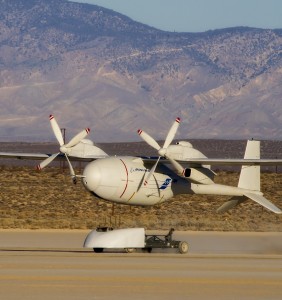Boeing eyes global coverage with Phantom Eye
Now that Boeing’s Phantom Eye unmanned plane is flying again, the company will take a cautious approach toward sending the Boeing-funded aircraft to an altitude of 65,000 feet, where it would have an incredible view.
The view would only come once Boeing has the confidence to install an expensive sensor package. Phantom Eye can carry up to 450 pounds of equipment, but it will carry ballast until Boeing proves it won't crash.
“We want to operate this vehicle safely, that’s the first goal. The second goal is to get it up to the altitude,” said Drew Mallow, Boeing’s Phantom Eye program manager. “We’re going to slowly expand the envelope of Phantom Eye with the eventual goal of getting up to 65,000 feet.”
The big intelligence pitch likely will come with the larger version of Phantom Eye Boeing wants to build. Before it can do that, Boeing needs to prove the endurance capability of the plane’s twin, hydrogen-fueled engines, which were adapted from Ford Ranger pickup truck engines.
The hydrogen engines sound daring compared to traditional aviation fuel engines, but Boeing calculates the risks will be worth it:
“Hydrogen has three times the energy content of normal av gas, so it allows us to, with the amount of hydrogen we can store on the vehicle, have quite long endurance,” said Boeing’s Brad Shaw, chief program engineer for Phantom Eye.
A larger version of Phantom Eye would have a wingspan of 250 feet compared to Phantom Eye’s 150-foot span. It would fly for up to 10 days compared to Phantom Eye’s four, with the exact endurance depending on the weight of the payload, Boeing said.
“That would allow you with basically three vehicles to...cover almost the entire globe (with) a surveillance-type capability,” Mallow said.
First things first though. Phantom Eye flew to an altitude of 8,000 feet Feb. 25 and landed without incident on the same dry lakebed in California where the plane broke its nose wheel on its inaugural flight last June.
Phantom Eye flew for 66 minutes and cruised at 62 knots this time.
The June 1, 2012 flight taught Boeing some rough lessons. Engineers turned to the company’s landing gear experts for the F-15 and F/A-18 to help build and install a stronger gear system.
Boeing also changed the location of the cutters that Phantom Eye’s nose wheel uses to break through the Mylar covering that keeps the nose aerodynamic. The cutters dragged on the lakebed during the inaugural flight.
Maybe most importantly, they added an aerodynamic fairing to the wheeled takeoff cart Phantom Eye uses so it can land on skids and a single nose wheel.
“That was to address takeoff acceleration in the second flight -- so again, that was a lesson learned from the first flight,” said Shaw.
This article was updated March 6



